モノサスと小林茂さんのつながりが生まれたのは2年前、渋谷ヒカリエで行われた「Tokyo Work Design Week」( TWDW )でのことでした。Google が運営するイノベーション東北*の「インターネットで、みんなが地域にできること」のゲストとして登壇していただいたのが、始まりです。
以後、小林さんとは「地域 × テクノロジー」をテーマとしたハッカソン「 Field Hack 」を通じて、活動を共にしてきました。
これまで3回開催した「 Field Hack 」の企画や運営を通じてご一緒した弊社の上原は、「小林先生はいつも好奇心旺盛で、楽しそう。仕事は驚くほど早く厳しさも感じるけど、物腰はやわらか。仕事において想いを持ち続けていける力の源を聞いてみたい」と話します。
* イノベーション東北:各地で地域活性のためのプロジェクトへ挑戦する人と、そのプロジェクトに参加したい人とをつなぐ、Google 主催のマッチングプラットフォーム。モノサスも運営のお手伝いをしていた。
さまざまなメディアクリエイターを輩出している情報科学芸術大学院大学[ IAMAS ]の教授であり、 Ogaki Mini Maker Faire の総合ディレクターを務め、メーカー(企業)とメイカー(個人の作り手)、ユーザーをつなげるなど、Maker ムーブメントの立役者として活動を続ける小林さん。
その活躍の幅は広く、Maker Faire Tokyo(2012年から、それまではMake: Tokyo Meeting) や、Engadget 日本版での電子工作部というユニークな活動の立ち上げに関わり、モノサスとのつながりの中だけでは知ることのできない“謎”がたくさんあります。
今回、めぐるモノサシに登場していただき、小林さんの考え方、働き方について、 Field Hack でご一緒した上原より、じっくりお話をうかがいたいと思います。
(聞き手:上原健 / インタビュー構成:佐口賢作)
-
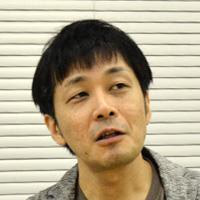
-
小林 茂さんプロフィール:
博士(メディアデザイン学・慶應義塾大学大学院メディアデザイン研究科)。1993年より電子楽器メーカーに勤務した後、2004年よりIAMAS。Arduino Fioなどのツールキット開発に加えて、オープンソースハードウェアやデジタルファブリケーションを活用し、多様なスキルや視点・経験を持つ人々が協働でイノベーション創出に挑戦するための方法論を探求。著書に『Prototyping Lab 第2版』など。
普段はコラボレーションすることはない人たちが
どうやったら出会い、力を会わせることができるのか
上原
そもそものお話からなんですが、小林先生はどういう経緯で IAMAS* の教授になり、現在のような活動をするようになっていったんですか?
*2 IAMAS(イアマス):岐阜県大垣市にある情報科学芸術大学院大学。メディア文化における探求者の養成を主な目的とする大学院のみの公立大学。芸術と科学の融合を建学の理念とし、先端技術と文化を織り交ぜた実践的な表現を主な研究テーマとしており、さまざまなメディアアーティスト、クリエイターを輩出している。(wikipedia「情報科学芸術大学院大学」(2017.08.23時点)参照)
小林さん(以下、敬称略)
大学を出た後、電子楽器メーカーに就職しました。最初に携わった仕事は、電子楽器の中に入る音を作ること。非常に特殊なジャンルのサウンドクリエイターでした。
なんで、その仕事をやりたかったかというと、電子楽器メーカーにしかない役割で、作った音が最終的にユーザー、プレイヤーとの接点になっていく。そこをデザインできるというのは、すごくおもしろいと思ったんですよね。
ちょうど会社としてその部門に新人を 1人増やそうとしているタイミングで、順番待ちのような状況もなく、すぐに仕事としてできた幸運もありました。ただ、生来飽きっぽいところがありまして。いくつかの商品に関わった後、新しいチャレンジとして、社内の技術研究所で生まれる新しいテクノロジーの種を製品につなげていく仕事に携わりました。
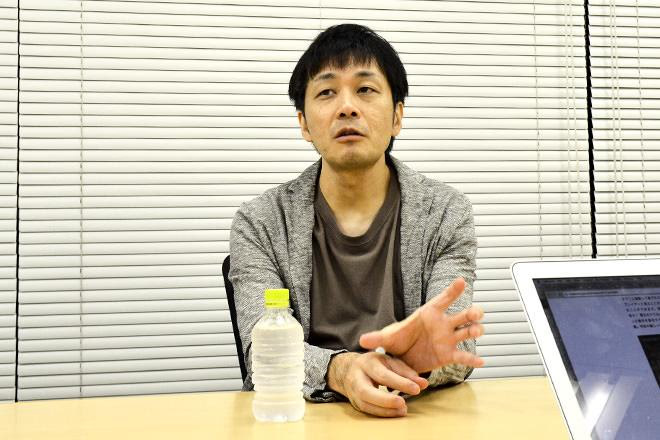
上原
新規事業の立ち上げのような仕事ですか?
小林
今で言うプロトタイピングですね。研究している本人たちはポテンシャルを感じているけれど、他の人が見たときに理解できる状態になっていない技術。それを見たり、触れたりして、その可能性を感じられる状態にする仕事でした。
そこから派生して、新規事業の立ち上げにも関わることができて、会社員時代を振り返ると本当におもしろいことばかりやらせてもらいました。
上原
そこからどういう経緯で、IAMAS へ?
小林
IAMAS の教授に赤松正行という人がいます。 彼が2002年に開催した「DSP Summer School 2002」というワークショップに招いた講師のJoshua Kit Claytonという方が英語しか喋らない人だったので、ツールの用語、数学的概念を含めた通訳ができる人はいないか? と。楽器メーカーの知り合い経由で話が回ってきたんですね。
僕は英語そのものがすごく得意なわけではなかったんですが、新しいツールのβテストからお手伝いできると聞いて興味を持ち、手を挙げました。
そのときの縁で赤松さんには覚えていただけたようで IAMAS のある方が退官するタイミングで、「IAMASにきませんか?」と声をかけていただいたんです。ただ、そのときは会社での新規事業が立ち上がりかけだったのでお断りしました。その製品が世に出た後、幸運なことにもう一度お声かけいただき、その時はちょうど何か新しいことに挑戦したいと思っていたときだったので「お願いします」と。そんな縁からの IAMAS でした。

IAMASのWebサイト(2017.09.05現在)
上原
現在のメーカーとメイカー、ユーザーをコーディネートとするような活動には当時から興味をお持ちだったんですか?
小林
そこは運やタイミングと外的な要因が重なりながら膨らんでいった感じです。
IAMAS の講師になって、「つくりたいものがあるのに電子回路の知識がない。でも、インタラクティブなものを作りたい」というデザイナーやアーティストに役立つツールを探していたんですね。
既成品を試し、ワークショップ形式で教えてみたりもしたんですが、どうもかゆいところに手が届かない。じゃあ、いっそ自分たちで作ってしまおうか、と。
同じような問題意識を持っている教員や学生たちが何人か集まり、「 Gainer* 」というツールを開発。自分たちで使うつもりが、外部の人たちに見せたら「発売するべきだ」と言われ、卒業生の伝手で試験的に売ってみることになったんです。
そんな手作りな感じで作ったものを世の中に出すことを経験した流れから、ICC という NTT のミュージアムに展示作品を出すことになり、外部の人たちを巻き込んで準備をしたり……。

*Gainer:ユーザー・インタフェースやメディア・インスタレーションのためのオープンソースのツールキット。加速度センサ(加速度や傾きを測る)・振動センサ(どれくらい震えているかを測る)・タッチセンサ(どのくらいの力で触れているかを測る)・焦電センサ(人を感知する)など、多様な機能を備えている。(KAKEHASHI『【小林茂】オープンソースのハードウェア「Gainer」の開発者』:参照)
写真提供:ICC
なんでしょうか。自分たちで蒔いた種がキッカケになったところはあるんですが、外的な要因も重なって、次につながっていきました。たぶん今だったら、ちょっとくらい新しいツールを作っても話題にならないですし、注目もされないと思います。
ただ、当時は目新しく、そこに運やタイミングが加わったんだと思います。また、自分たちの作ったツールを使ってデザイナーやアーティストがいろいろな作品を生み出していく現場にも立ち会うことがきたのも幸運でした。
上原
「 Field Hack 」でご一緒していても感じるんですが、小林先生は“場”を作っていく仕事がお好きなんでしょうか?
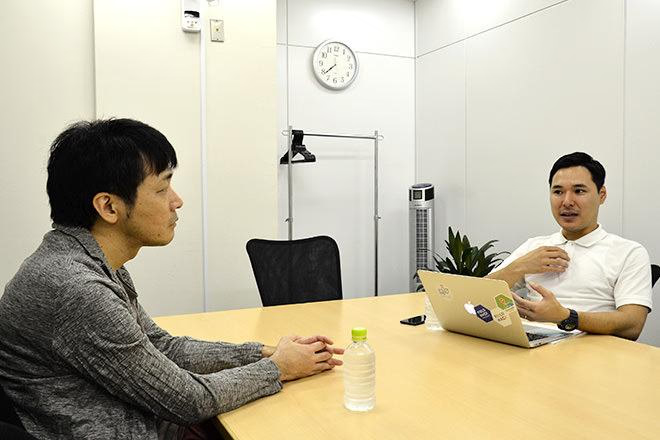
左:小林先生、右:上原(聞き手)
小林
単に飽きやすい性格もあるんですけど、常に自分たちでチャレンジできる範囲で新しいことを生み出せるのはどこなんだろう? ということは意識しています。今、僕たちのいる IAMAS は、大企業のようにすごい資金力やマンパワーを使って力技のアプローチのできるところではないですが、逆に手弁当で動ける余地はあります。
それで起こせる力は小さなものですが、変化が大きいようなフィールドなら新しい物を送り出すことができるわけです。そういうフィールドがどこなんだろうと見ているし、自分たちだけでは無理ならどこと一緒だったらできるのかを常に考えつつ、やっている感じですかね。
上原
手を動かしての物づくりは?
小林
もちろん、手を動かしての物づくりは好きですよ。でも、自分で何かを作ったとしても、自分の能力の範囲内に収まってしまいます。今は IoT って言葉が「もういいや」ってくらいあちこちで言われるんですけど、どんな天才でも個人でできる範囲には限界があって、全てをプロフェッショナルなレベルでつくることはできないと思っています。
そう思うと、自分の力でできる範囲にこだわることにあまり意味は感じなくて、いろいろなスキル、経験、視点を持っている人たちがコラボレーションする場に期待しています。
普通に過ごしていたらうまくコラボレーションすることはない人たちがどうやったら出会い、力を合わせることができるのか。その方法論をみつけて、提供し、さらにいろんな現場でやりながらより良くしていく仕事。そっちの方が自分としても、うまくコミットできるかなと感じているんですよね。
Maker Faire Tokyo、電子工作部、そしてField Hackへ
メーカーとメイカー、メイカーと地域をつなげる活動のはじまり
上原
「 Maker Faire Tokyo 」に関わるようになったキッカケを教えてください。
小林
お話したように、僕自身がメーカーでサウンドデザインや新規事業系の仕事をしていました。現場にいる人はご存知の通り、一般の人には知られていないさまざまなおもしろい開発が行われています。
当時から、こうした試みをなんとか多くの人に知ってもらえないか。そのおもしろさが伝われば、メーカーの人たちと製品を使う人たちが理解し合えるようになるのではと思っていたんですね。
ですが、現実には電子回路やソフトウェアのようなテクノロジーが入った製品はブラックボックスになってしまって、一部の人だけが理解できる特殊なものだと遠ざけられていたんです。でも本当はホームセンターで材料を買ってきて DIY で家具を作るように、テクノロジーも誰もが手で触れて作っていけるもののはずなんです。
そんな意識を持っていた頃、アメリカ発のテクノロジー系 DIY 工作専門雑誌「 Make」が生まれ、向こうで Maker Faire が始まり、「 Makerムーブメント」が日本にもやってきました。
それが 2008年の春のことで、隅田川沿いのインターナショナルスクールの古い体育館を会場に「 Make: Tokyo Meeting* 」が開かれたんです。この「 Maker Faire Tokyo 」の前身となるイベントをお手伝いしたのが、始まりです。ちなみに、「 Make: Tokyo Meeting 」は約30組の出展者と600名の来場者による手作りのイベントでした。
*株式会社オライリー・ジャパンが主催する電子工作メインのイベント
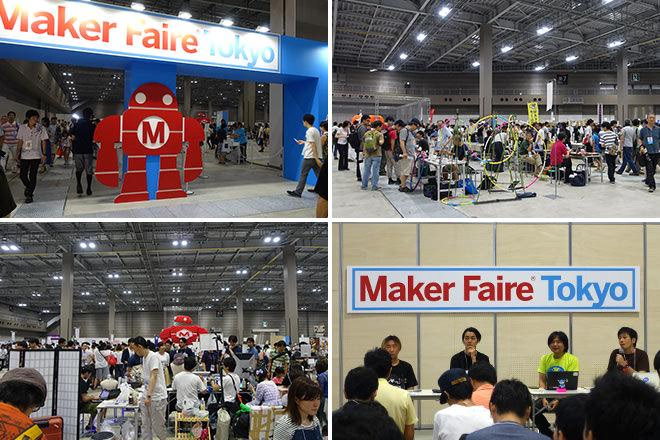
2017年8月におこなわれた Maker Faire Tokyo のようす。当日はたくさんのメーカーやメイカー、そしてユーザーが一同に会した。
上原
今の「 Maker Faire Tokyo 」は出展者も来場者も10倍以上の規模になっていますね。
小林
最初の頃、おもしろかったのは、イベントの価値も定まっていないですし、主催者側もどうやればいいのかが明らかじゃないわけです。そんなよくわからないことに対して興味を持って集まってきてくれる人というのは、それなりに自発的に動いている人たちなんですよね。
印象に残っているのは、「 Make: Tokyo Meeting 」のときも、IAMAS として大垣で「 Ogaki Mini Maker Faire 」を始めたときも、「これは何なんだ?」と説明するのがすごく大変で。見たことがある人に対して、「おもしろいからやりませんか?」と声掛けするのは簡単ですが、誰も見たこともないイベントをやる場合、メディアとのやりとりも「それって展示会なんですか?」「いや、そうではありません」、「展覧会ですか?「いや、そうではありません」、「フリーマーケットですか?」「いや、そうではありません」、「じゃあ、コミケ的なものですか?」「いや、そうではありません」、「研究発表ですか?」「それでもありません」と(笑)。
展示会、展覧会、研究発表のいずれでもないし、いずれでもあるわけです。だから、新聞の取材で「ひと言で言ってください」と言われても、「言えないんです、そこが魅力なんです」と伝えていき、わかってくれるのって、10紙あれば、1紙か、よくて2紙。本当にその場に行かないとわからない魅力を実際に来てくれた人たちが、「たしかにそうだね」「よくわからなかったけど、来たらおもしろい」と言ってくれて、広がっていった。その現場にいられたのは贅沢なことですよね。
上原
「 Ogaki Mini Maker Faire 」を含め、小林先生は地域で新しい試みを始めることにも力を入れていらっしゃる印象があります。
小林
僕らが普段いるところは地方都市なので、東京の後追いのことをやってもしょうがないんですよね。劣化コピーみたいになっちゃうので。「初めて地方でやりました」よりも「東京でもできないことを先にやりました」の方がおもしろいでしょう。
上原
「 Field Hack 」も小林先生の提案書が始まるキッカケの1つとなりました。
小林
2015年に「 Tokyo Work Design Week 」( TWDW )で、イノベーション東北の「インターネットで、みんなが地域にできること」のゲストとして呼んでもらいました*。当時、僕の中には「なんかもう一歩先に行きたい」という思いがあったんですよね。
*第3部:Geek in Local|ギークが地域で起こすイノベーション
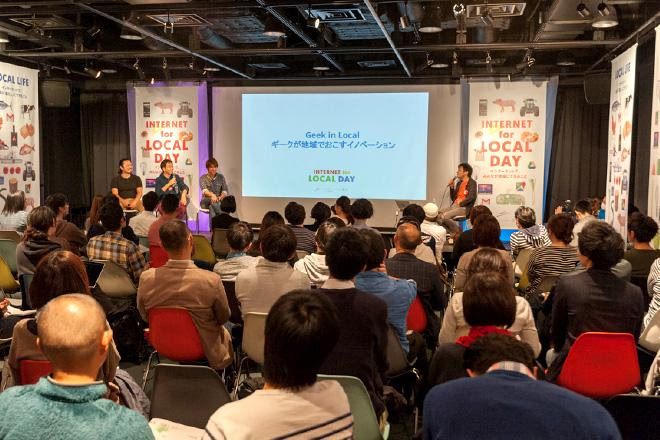
2015年11月22日に渋谷ヒカリエでおこなわれた「インターネットで、みんなが地域にできること」の第3部「Geek in Local|ギークが地域で起こすイノベーション」での会場のようす
というのは、Engadget 日本版で電子工作部*というイベントを一緒に立ち上げ、自主開催からスタートして企業がスポンサーに付き、継続していく過程で、本当に短期間で自分たちのアイデアを体現できるメイカーの人たちがたくさんいるのがわかったんです。
ただそれはイベントの期間中だけに限られていて、終わった後にそこから先へプロジェクトなりが継続することは難しい。イベントとして成果は出ました。メイカーのコミュニティもできました。それでいいのかもしれない。でも、短期間でここまでできるんだったら、次に進めたらすごいのにな、もったいないなとも思ってきたわけです。
じゃあ、どうすればいいのかと考えている時期に、「テクノロジーが地域でできること」のセッションがあり、主催していたメンバーとも話すうち、ここにうまくいく方法があるかもしれないと思ったんですね。
それで、Engadget 側、イノベーション東北サイドにすごくざっくりした「 Field Hack 」の提案書を出しました。
*Engadget 日本版の電子工作部:2013年にはじまった初対面の人たちがチームを組んでプロトタイプを作るという参加型のイベント。(詳しくは Engadget 日本版『「そこから何かを作り出したい」IAMAS小林茂教授[1]:電子工作部列伝』にて)
上原
それが2016年1月の初旬くらいでしたね。そのとき僕は初めて小林先生とお会いして、ちょうどイノベーション東北も「テクノロジーで地域に対して何ができるのか?」というビジョンを考えているところで。「とりあえずやりましょう」という話になって、初回「 Field Hack ONAGAWA 」はゴールデンウィークの開催でした。今思えば、すごいスピードでしたね。
小林
たしかに1回目は何なのかよくわからない状態でのスタートでしたね。僕も参加者を集めるために、Facebook で個人的に「どうですか?」と送った人もいますし、「よくわからないけど、おもしろいはずです」って何の根拠もないことを発信し続けるってことをしていました。
でも、「初めてだからおもしろいに違いない」と思ってくださった方もたくさんいて、それは本当にうれしくもあり。また、1回目は参加者のモチベーションの幅がかなり広かったんですよね。
上原
本当にいろんな方がいました。
小林
やっぱり1回目の開催地の女川というのが象徴的で。東日本大震災で大きな被害を受け、復旧から復興へという動きについてもトップランナーとして動いている場所ですから。
参加してくれた方も、震災とのつながりがかなり強かったと思うんですよね。当時、ボランティアで訪れていた人、あのときは行けなかったけど、今だったら何かできるんじゃないかと考えてくれた人。そういう方が少なからずいたので、いわゆるメイカーが集まる場とはまた違った雰囲気がありました。
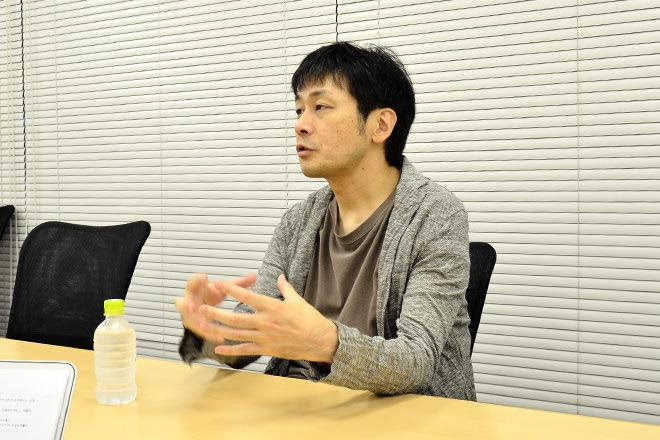
上原
女川の後、1つの学びとして出たのが、テーマの重要性です。どこに向けて物を作るのか。そこをさらに細かく設定してみるということで2回目の「 Field Hack TONO 」では、協力団体として参画いただいた Next Commons Lab が遠野市で立ち上げたプロジェクトに合わせて、5個のテーマを掲げて、参加者を募りました。
そして、3回目の「 Field Hack YOSANO 」では1回目、2回目を通じて見えてきた、「 Field Hack 」後へのつながりの重要性、プロジェクトを続けていくということに対して行政にもディスカッションに入ってもらうといった試みをしました。一過性のイベントで終わらず、次に向けたビジョンをそれぞれが持ちながら解散できたのかなと思うんですが、どうでしょうか?
小林
そう思いますね。その後、どう進んでいるかは様子を聞いてみたいところです。
1回目にはゼロからイチにする、生まれるときのおもしろさがあったと同時に、定まっていないがゆえのいろいろな混乱もありました。それが 2回目、3回目でだんだん解消されたというか。
でも、「 Field Hack 」にしても、立ち上げたイベントというのはうまく回り始めると、だんだん寂しくなってくるんですよね(笑)。主催者は初日をスタートさせるまで調整に追われるわけですけど、うまく回っていったらあとは別に手を出さず、むしろ、表に出ない方がいいくらいですよね。
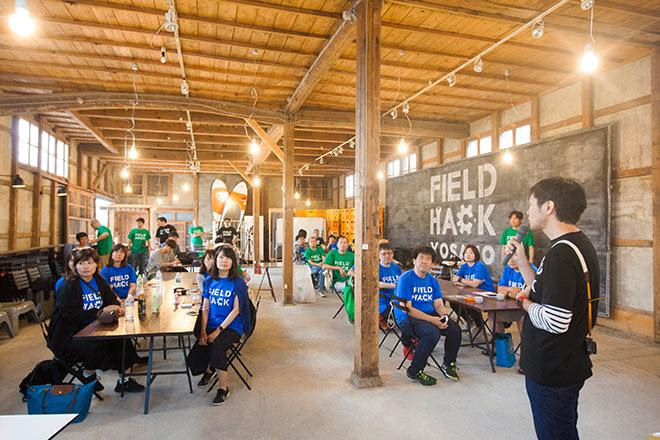
2017年6月、7月に行われた Field Hack YOSANO のようす
上原
そうですね。
小林
そうなってくると、明らかに参加者の方が楽しそうだな。参加したいなと思ってしまう(笑)。
(後編に続く)

